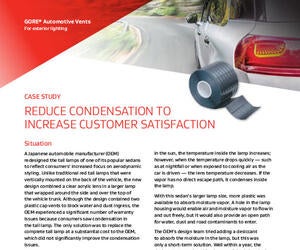GORE® Automotive Vents Reduce Condensation to Increase Customer Satisfaction
Case Studies, United States
A Japanese OEM saw a significant number of warranty issues because consumers saw condensation in the tail lamp. A year and a half after incorporating Gore’s recommendations, the warranty claims decreased resulting in significant cost savings and increased customer satisfaction.
Situation
A Japanese automobile manufacturer (OEM) redesigned the tail lamps of one of its popular sedans to reflect consumers’ increased focus on aerodynamic styling. Unlike traditional red tail lamps that were vertically mounted on the back of the vehicle, the new design combined a clear acrylic lens in a larger lamp that wrapped around the side and over the top of the vehicle trunk. Although the design contained two plastic cap vents to block water and dust ingress, the OEM experienced a significant number of warranty issues because consumers saw condensation in the tail lamp. The only solution was to replace the complete tail lamp at a substantial cost to the OEM, which did not significantly improve the condensation issues.
Challenge
In Japan, the OEM’s engineering team found that several factors in the lamp’s design contributed to the increased condensation issues. First, condensation is much more visible through clear lenses than through red lenses, so car owners were more aware of the issue. Second, the wrap-around design had a larger surface area of plastic that was directly exposed to the heat of the sun. Acrylic plastics have high moisture absorption and permeation rates, and the sun’s heat releases that moisture into the lamp. As the car sits in the sun, the temperature inside the lamp increases; however, when the temperature drops quickly — such as at nightfall or when exposed to cooling air as the car is driven — the lens temperature decreases. If the vapor has no direct escape path, it condenses inside the lamp.
With this sedan’s larger lamp size, more plastic was available to absorb moisture vapor. A hole in the lamp housing would enable air and moisture vapor to flow in and out freely, but it would also provide an open path for water, dust and road contaminants to enter.
The OEM’s design team tried adding a desiccant to absorb the moisture in the lamp, but this was only a short-term solution. Well within a year, the desiccant stopped working because it had absorbed the maximum amount of moisture possible. The OEM needed a solution that would address the accumulated moisture without creating a path for contaminants.
Solution
The OEM’s engineering team in Japan contacted Gore for help. The lighting engineers in Gore’s global automotive group drew on their experience in venting solutions to recommend the GORE® Automotive Vents Series AVS 9. This vent equalizes pressure by allowing air to flow freely in and out of the lamp and reduces condensation due to its high water-vapor diffusion rate. At the same time, the vent withstands Water Entry Pressure (WEP) of more than 5 psi (345 mbar) for 60 seconds and serves as a barrier against dust, dirt and road debris to keep the inside of the lens clean for the life of the vehicle.
.
Gore’s team collaborated with the OEM to evaluate several venting configurations that they tested rigorously, from lamp testing in the laboratory to extended on-car trials. Gore evaluated a variety of potential solutions in different driving scenarios and environmental conditions. As a result of this testing, the team recommended a design that combines the GORE® Automotive Vent with the two cap vents.
According to the OEM’s lead engineer, they turned to Gore because of its global experience in the automotive lighting industry. “We had worked with Gore on several of our headlamp applications, and they have always been quick to respond. They have the technical resources, facilities and market expertise to address our design challenges on a global level. A year and a half after we incorporated their recommendations, our warranty claims were steadily decreasing. That’s a significant savings for us — not to mention the increase in customer satisfaction and brand loyalty.”
FOR INDUSTRIAL USE ONLY
Not for use in food, drug, cosmetic or medical device manufacturing, processing, or packaging operations.
